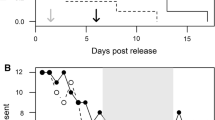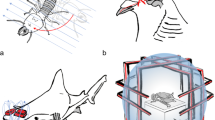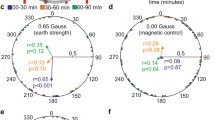Abstract
The role of microbiome in shaping animal’s behavior is well established. Accordingly, the use of antibiotics may have profound effects on behavior, which are seldom examined. Recently, the symbiotic magnetic-sensing hypothesis has been forwarded as a mechanistic explanation for the phenomenon of animal magnetoreception. It suggests a symbiotic relationship between magnetotactic bacteria (MTB) and the navigating host. To establish a research protocol for future behavioral studies, we examined the effect of a widely used antibiotic substance on migratory restlessness orientation and on magnetotactic bacteria. Using migrating Eurasian reed warblers, we show that in contrast to the control group, antibiotic treatment caused a lack of clear directionality in an Emlen funnel experiment. Accordingly, the antibiotic treatment group showed a significant increase in directional variance. This effect of antibiotics on behaviors associated with animal magnetic sensing might be considered as preliminary experimental support of the symbiotic magnetic-sensing hypothesis. Further, we lay a preliminary experimental protocol that could be implemented in experiments aiming to prove or refute the symbiotic magnetic sensing hypothesis.

Similar content being viewed by others
References
Able KP (1982) Field studies of avian nocturnal migratory orientation I. interaction of sun, wind and stars as directional cues. Anim Behav 30:761–767
Åkesson S, Walinder G, Karlsson L, Ehnbom S (2001) Reed warbler orientation: Initiation of nocturnal migratory flights in relation to visibility of celestial cues at dusk. Anim Behav 61:181–189
Baedke J, Fábregas-Tejeda A, Delgado AN (2020) The holobiont concept before Margulis. J Exp Zool B Mol 334(3):149–155. https://doi.org/10.1002/jez.b.22931
Callens M, Watanabe H, Kato Y, Miura J, Decaestecker E (2018) Microbiota inoculum composition affects holobiont assembly and host growth in Daphnia. Microbiome 6(1):56
Collins S, Berrick P (2009) The relationship between intestinal microbiota and the central nervous system in normal gastrointestinal function and disease. Gastroenterology 136(6):2003–2014
de Melo RD, Acosta-Avalos D (2017) Light effects on the multicellular magnetotactic prokaryote ‘Candidatus Magnetoglobus multicellularis’ are cancelled by radiofrequency fields: the involvement of radical pair mechanisms. Int J Gen Mol Microbiol 110:177–186
Edelman NB, Fritz T, Nimpf S, Pichler P, Lauwers M, Hickman RW, Papadaki-Anastasopoulou A, Ushakova L, Heuser T, Resch GP, Saunders M (2015) No evidence for intracellular magnetite in putative vertebrate magnetoreceptors identified by magnetic screening. PNAS 112(1):262–267
Edwards KJ, Simmons SL, Sievert SM, Frankel RB, Bazylinski D (2004) Spatiotemporal distribution of marine magnetotactic bacteria in a seasonally stratified coastal salt pond spatiotemporal distribution of marine magnetotactic bacteria in a seasonally stratified coastal salt pond. Appl Environ Microbiol 70:6230–6239
Emlen ST, Emlen JT (1966) A technique for recording migratory orientation of captive birds. Auk 83(3):361–367
Formella M, Przemyslaw B (2002) Directional preferences of the reed warbler (Acrocephalus scirpaceus) and the sedge warbler (A. schoenobaenus) on autumn migration at Lake Drużno (Poland). The Ring 24:15–29
Franckel RB (1984) Magnetic guidance of organisms. Annu Rev Biophys Bioeng 13:85–103
Gonzalez A, Stombaugh J, Lozupone C, Turnbaugh PJ, Gordon JI, Knight R (2011) The mind-body-microbial continuum. Dialogues. Clin Neurosci 13:55–62
Hayward A, Robert P, Shinichi N (2021) A broadscale analysis of host-symbiont cophylogeny reveals the drivers of phylogenetic congruence. Ecol Lett 24(8):1681–1696
Hore PJ, Mouritsen H (2016) The radical pair mechanism of magnetoreception. Annu Rev Biophys 45:299–344
Inyinbor AA, Bello OS, Fadiji AE, Inyinbor HE (2018) Threats from antibiotics: a serious environmental concern. J Environ Chem Eng 6:784–793
Kiraly DD, Walker DM, Calipari ES, Labonte B, Issler O, Pena CJ, Ribeiro EA, Scott J, Russo SJ, Nestler EJ (2016) Alterations of the host microbiome affect behavioral responses to cocaine. Sci Rep 6(1):1–12
Kishkinev D, Chernetsov N, Pakhomov A, Heyers D, Mouritsen H (2015) Eurasian reed warblers compensate for virtual magnetic displacement. Curr Biol 25:R822–R824
Kolodny O, Callahan BJ, Douglas AE (2020) The role of the microbiome in host evolution Phil. Trans R Soc B 375:2019058820190588
Landler L, Ruxton GD, Malkemper EP (2021) Advice on comparing two independent samples of circular data in biology. Sci Rep 11(1):1–10
Lefèvre CT, Bazylinski DA (2013) Ecology, diversity, and evolution of magnetotactic bacteria. MMBR 77(3):497–526
Lloyd-Price J, Abu-Ali G, Huttenhower C (2016) The healthy human microbiome. Genome Med 8(1):51
Logan AC, Katzman M (2005) Major depressive disorder: probiotics may be an adjuvant therapy. Med Hypotheses 64:533–538
Margulis L (1990) Words as battle cries: symbiogenesis and the new field of endocytobiology. Bioscience 40(9):673–677
Margulis L, René F (1991) Symbiosis as a source of evolutionary innovation: speciation and morphogenesis. Mit Press, Cambridge
Marr P G (2014) Directional (circular) statistics. http://webspace.ship.edu/pgmarr/Geo441/Lectures/Lec%2016%20%20Directional%20Statistics.pdf. Accessed Jan 2019
Meyer-Abich A (1943) I. Das Typologische Grundgesetz und Seine Folgerungen Für Phylogenie und Entwicklungsphysiologie. Acta Biotheoretica 7.1: 1–80
Mitchell MA (1988) Enrofloxacin. Drugs Future 13:305–307
Monteil CL, Vallenet D, Menguy N, Benzerara K, Barbe V, Fouteau S, Cruaud C, Floriani M, Viollier E, Adryanczyk G, Leonhardt NE (2019) Bacteria at the origin of magnetoreception in a marine protist. Nat Microbiol 4(7):1088–1095
Mouritsen H (2012) Search for the compass needles. Nature 484(7394):320–321
Muheim R, Åkesson S, Bäckman J, Sjöberg S (2017) Magnetic compass orientation research with migratory songbirds at Stensoffa Ecological Field Station in southern Sweden: why is it so difficult to obtain seasonally appropriate orientation? J Avian Biol 48:6–18
Natan E, Vortman Y (2017) The symbiotic magnetic-sensing hypothesis: do magnetotactic bacteria underlie the magnetic sensing capability of animals. Mov Ecol 5:22–27
Natan E, Fitak RR, Werber Y, Vortman Y (2020) Symbiotic magnetic sensing: raising evidence and beyond. Phil Trans B 375(1808):20190595
Nordmann GC, Hochstoeger T, Keays DA (2017) Unsolved mysteries: magnetoreception—a sense without a receptor. PLoS Biol 15:1–10
Pearson DJ, Small BJ, Kennerley PR (2002) Eurasian Reed Warbler: the characters and variation associated with the Asian form fuscus. Br Birds 95:42–61
Pita L, Laura R, Beate MS, Andrea F, Ute H (2018) The sponge holobiont in a changing ocean: from microbes to ecosystems. Microbiome 6(1):1–18
Qian X, Zhao Y, Santini CL, Pan H, Xiao T, Chen H, Song T, Li J, Alberto F, Brustlein S, Wu LF (2021) How light affect the magnetotactic behavior and reproduction of ellipsoidal multicellular magnetoglobules? J Oceanol Limnol 39(6):2005–2014
R Core Team (2021) R: A language and environment for statisticl computing. R foundation for statitical computing. Vienna, Austria. URL https://www.R-project.org/. Accessed Dec 2021
Ravanbakhsh M, Rashmi S, Laurentius AV, George AK, Alexandre JO (2018) Microbial modulation of plant ethylene signaling: ecological and evolutionary consequences. Microbiome 6(1):1–10
Ritz T, Adem S, Schulten K (2000) A model for photoreceptor-based magnetoreception in birds. Biophys J 78:707–718
Rosenberg E, Koren O, Reshef L, Efrony R, Zilber-Rosenberg I (2007) The role of microorganisms in coral health, disease and evolution. Nat Rev Microbiol 5:355–362
Sapp J (2002) Paul Buchner (1886–1978) and hereditary symbiosis in insects. Int Microbiol 5(3):145–150
Schneider CA, Rasband WS, Eliceiri KW (2012) NIH Image to ImageJ: 25 years of image analysis. Nat Methods 9(7):671–675
Simon JC, Marchesi JR, Mougel C, Selosse MA (2019) Host-microbiota interactions: from holobiont theory to analysis. Microbiome 7(1):1–5
Treiber CD, Salzer MC, Riegler J, Edelman N, Sugar C, Breuss M, Pichler P, Cadiou H, Saunders M, Lythgoe M, Shaw J (2012) Clusters of iron-rich cells in the upper beak of pigeons are macrophages not magnetosensitive neurons. Nature 484(7394):367–370
Vannier N, Mony C, Bittebiere AK, Michon-Coudouel S, Biget M, Vandenkoornhuyse P (2018) A microorganisms’ journey between plant generations. Microbiome 6(1):79
Walker MM, Kirschvink JL, Chang SBR, Dizon AE (1984) A candidate magnetic sense organ in the yellowfin tuna. Thunnus Albacares Science 224(4650):751–753
Weber T, Houston AI, Ens BJ, Weber TP, Houston AI, Ens B (2018) Optimal departure fat loads and stopover site use in avian migration: an analytical model. Proc Royal Soc B 258(1351):29–34
Wiltschko W, Wiltschko R (1990) Magnetic orientation and celestial cues in migratory orientation. Experientia 46:342–352
Zapka M, Heyers D, Hein CM, Engels S, Schneider NL, Hans J, Weiler S, Dreyer D, Kishkinev D, Wild JM, Mouritsen H (2009) Visual but not trigeminal mediation of magnetic compass information in a migratory bird. Nature 461(7268):1274–1277
Acknowledgements
We would like to thank Shay Agmon of the Hula ringing station and the Hula Research Center staff for their assistance throughout the project. We further wish to thank the KKL-JNF for supporting the Hula Research Center. This research was supported by the Israel Science Foundation (grant No. 1350/21).
Author information
Authors and Affiliations
Corresponding author
Ethics declarations
Conflict of interest
This study was funded by KKL-JNF, Israel. All authors declare no conflict of interest. All the protocols mentioned above, including capture, handling, and antibiotic treatment were performed under necessary permits from Israel’s nature and park authority. Permit number for 2018: 41885, and for 2017: 41589.
Additional information
Publisher's Note
Springer Nature remains neutral with regard to jurisdictional claims in published maps and institutional affiliations.
About this article
Cite this article
Werber, Y., Natan, E., Lavner, Y. et al. Antibiotics affect migratory restlessness orientation. J Ethol 40, 175–180 (2022). https://doi.org/10.1007/s10164-022-00747-0
Received:
Accepted:
Published:
Issue Date:
DOI: https://doi.org/10.1007/s10164-022-00747-0




